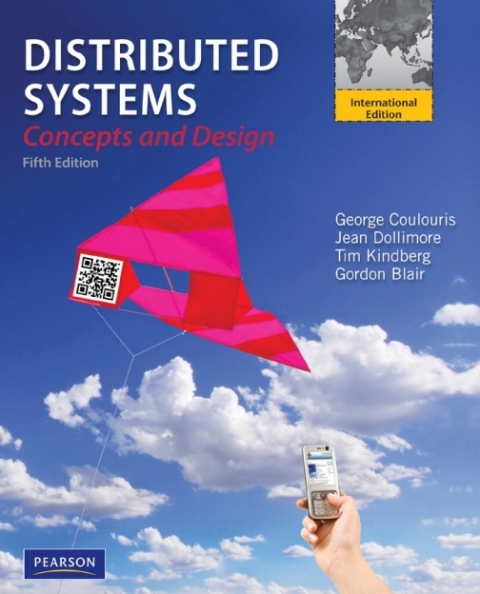Description
Efnisyfirlit
- CONTENTS
- PREFACE
- 1 CHARACTERIZATION OF DISTRIBUTED SYSTEMS
- 1.1 Introduction
- 1.2 Examples of distributed systems
- 1.3 Trends in distributed systems
- 1.4 Focus on resource sharing
- 1.5 Challenges
- 1.6 Case study: The World Wide Web
- 1.7 Summary
- 2 SYSTEM MODELS
- 2.1 Introduction
- 2.2 Physical models
- 2.3 Architectural models
- 2.4 Fundamental models
- 2.5 Summary
- 3 NETWORKING AND INTERNETWORKING
- 3.1 Introduction
- 3.2 Types of network
- 3.3 Network principles
- 3.4 Internet protocols
- 3.5 Case studies: Ethernet, WiFi and Bluetooth
- 3.6 Summary
- 4 INTERPROCESS COMMUNICATION
- 4.1 Introduction
- 4.2 The API for the Internet protocols
- 4.3 External data representation and marshalling
- 4.4 Multicast communication
- 4.5 Network virtualization: Overlay networks
- 4.6 Case study: MPI
- 4.7 Summary
- 5 REMOTE INVOCATION
- 5.1 Introduction
- 5.2 Request-reply protocols
- 5.3 Remote procedure call
- 5.4 Remote method invocation
- 5.5 Case study: Java RMI
- 5.6 Summary
- 6 INDIRECT COMMUNICATION
- 6.1 Introduction
- 6.2 Group communication
- 6.3 Publish-subscribe systems
- 6.4 Message queues
- 6.5 Shared memory approaches
- 6.6 Summary
- 7 OPERATING SYSTEM SUPPORT
- 7.1 Introduction
- 7.2 The operating system layer
- 7.3 Protection
- 7.4 Processes and threads
- 7.5 Communication and invocation
- 7.6 Operating system architecture
- 7.7 Virtualization at the operating system level
- 7.8 Summary
- 8 DISTRIBUTED OBJECTS AND COMPONENTS
- 8.1 Introduction
- 8.2 Distributed objects
- 8.3 Case study: CORBA
- 8.4 From objects to components
- 8.5 Case studies: Enterprise JavaBeans and Fractal
- 8.6 Summary
- 9 WEB SERVICES
- 9.1 Introduction
- 9.2 Web services
- 9.3 Service descriptions and IDL for web services
- 9.4 A directory service for use with web services
- 9.5 XML security
- 9.6 Coordination of web services
- 9.7 Applications of web services
- 9.8 Summary
- 10 PEER-TO-PEER SYSTEMS
- 10.1 Introduction
- 10.2 Napster and its legacy
- 10.3 Peer-to-peer middleware
- 10.4 Routing overlays
- 10.5 Overlay case studies: Pastry, Tapestry
- 10.6 Application case studies: Squirrel, OceanStore, Ivy
- 10.7 Summary
- 11 SECURITY
- 11.1 Introduction
- 11.2 Overview of security techniques
- 11.3 Cryptographic algorithms
- 11.4 Digital signatures
- 11.5 Cryptography pragmatics
- 11.6 Case studies: Needham–Schroeder, Kerberos, TLS, 802.11 WiFi
- 11.7 Summary
- 12 DISTRIBUTED FILE SYSTEMS
- 12.1 Introduction
- 12.2 File service architecture
- 12.3 Case study: Sun Network File System
- 12.4 Case study: The Andrew File System
- 12.5 Enhancements and further developments
- 12.6 Summary
- 13 NAME SERVICES
- 13.1 Introduction
- 13.2 Name services and the Domain Name System
- 13.3 Directory services
- 13.4 Case study: The Global Name Service
- 13.5 Case study: The X.500 Directory Service
- 13.6 Summary
- 14 TIME AND GLOBAL STATES
- 14.1 Introduction
- 14.2 Clocks, events and process states
- 14.3 Synchronizing physical clocks
- 14.4 Logical time and logical clocks
- 14.5 Global states
- 14.6 Distributed debugging
- 14.7 Summary
- 15 COORDINATION AND AGREEMENT
- 15.1 Introduction
- 15.2 Distributed mutual exclusion
- 15.3 Elections
- 15.4 Coordination and agreement in group communication
- 15.5 Consensus and related problems
- 15.6 Summary
- 16 TRANSACTIONS AND CONCURRENCY CONTROL
- 16.1 Introduction
- 16.2 Transactions
- 16.3 Nested transactions
- 16.4 Locks
- 16.5 Optimistic concurrency control
- 16.6 Timestamp ordering
- 16.7 Comparison of methods for concurrency control
- 16.8 Summary
- 17 DISTRIBUTED TRANSACTIONS
- 17.1 Introduction
- 17.2 Flat and nested distributed transactions
- 17.3 Atomic commit protocols
- 17.4 Concurrency control in distributed transactions
- 17.5 Distributed deadlocks
- 17.6 Transaction recovery
- 17.7 Summary
- 18 REPLICATION
- 18.1 Introduction
- 18.2 System model and the role of group communication
- 18.3 Fault-tolerant services
- 18.4 Case studies of highly available services: The gossip architecture, Bayou and Coda
- 18.5 Transactions with replicated data
- 18.6 Summary
- 19 MOBILE AND UBIQUITOUS COMPUTING
- 19.1 Introduction
- 19.2 Association
- 19.3 Interoperation
- 19.4 Sensing and context awareness
- 19.5 Security and privacy
- 19.6 Adaptation
- 19.7 Case study: Cooltown
- 19.8 Summary
- 20 DISTRIBUTED MULTIMEDIA SYSTEMS
- 20.1 Introduction
- 20.2 Characteristics of multimedia data
- 20.3 Quality of service management
- 20.4 Resource management
- 20.5 Stream adaptation
- 20.6 Case studies: Tiger, BitTorrent and End System Multicast
- 20.7 Summary
- 21 DESIGNING DISTRIBUTED SYSTEMS: GOOGLE CASE STUDY
- 21.1 Introduction
- 21.2 Introducing the case study: Google
- 21.3 Overall architecture and design philosophy
- 21.4 Underlying communication paradigms
- 21.5 Data storage and coordination services
- 21.6 Distributed computation services
- 21.7 Summary
- REFERENCES
- INDEX






Reviews
There are no reviews yet.